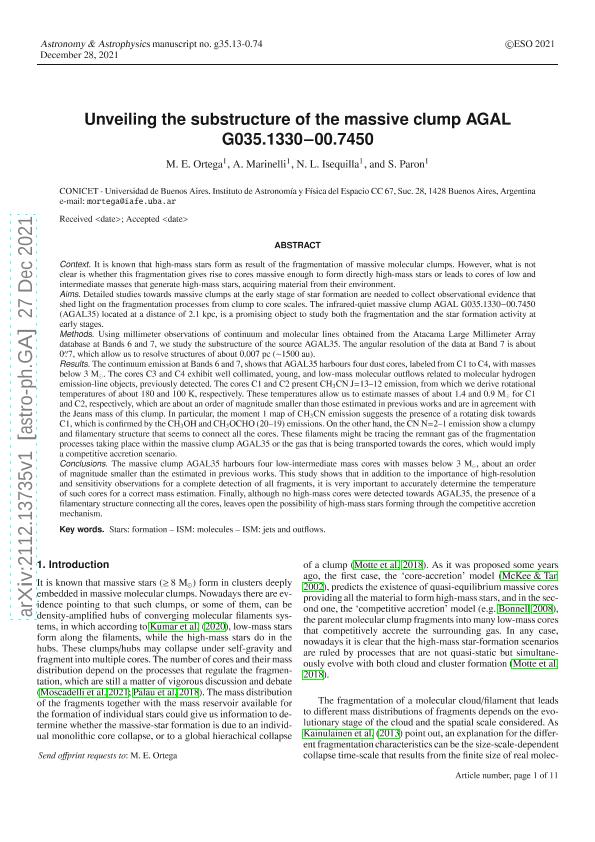Artículo
Unveiling the substructure of the massive clump AGAL G035.1330-00.7450
Ortega, Martin Eduardo ; Marinelli Andino, Alejandro Daniel
; Marinelli Andino, Alejandro Daniel ; Isequilla, Natacha Laura
; Isequilla, Natacha Laura ; Paron, Sergio Ariel
; Paron, Sergio Ariel
 ; Marinelli Andino, Alejandro Daniel
; Marinelli Andino, Alejandro Daniel ; Isequilla, Natacha Laura
; Isequilla, Natacha Laura ; Paron, Sergio Ariel
; Paron, Sergio Ariel
Fecha de publicación:
02/2022
Editorial:
EDP Sciences
Revista:
Astronomy and Astrophysics
ISSN:
0004-6361
Idioma:
Inglés
Tipo de recurso:
Artículo publicado
Clasificación temática:
Resumen
Context. It is known that high-mass stars form as the result of the fragmentation of massive molecular clumps. However, it is not clear whether this fragmentation gives rise to cores that are massive enough to directly form high-mass stars, or if leads to cores of low and intermediate masses that generate high-mass stars by acquiring material from their environment. Aims. Detailed studies of massive clumps at the early stage of star formation are needed to collect observational evidence that sheds light on the fragmentation processes from clump to core scales. The infrared-quiet massive clump AGAL G035.1330-00.7450 (AGAL35) located at a distance of 2.1 kpc is a promising object for studying the fragmentation and the star formation activity at early stages. Methods. Using millimeter observations of continuum and molecular lines obtained from the Atacama Large Millimeter Array database at Bands 6 and 7, we studied the substructure of the source AGAL35. The angular resolution of the data at Band 7 is about 0.′′7, which allowed us to resolve structures of about 0.007 pc (~1500 au). Results. The continuum emission at Bands 6 and 7 shows that AGAL35 harbors four dust cores, labeled C1 to C4, with masses lower than 3 M. Cores C3 and C4 exhibit well-collimated, young, and low-mass molecular outflows related to molecular hydrogen emission-line objects that were previously detected. Cores C1 and C2 present CH3CN J = 13-12 emission, from which we derive rotational temperatures of about 180 and 100 K, respectively. These temperatures allow us to estimate masses of about 1.4 and 0.9 M for C1 and C2, respectively, which are about an order of magnitude lower than those estimated in previous works and agree with the Jeans mass of this clump. In particular, the moment 1 map of CH3CN emission suggests the presence of a rotating disk towards C1, which is confirmed by the CH3OH and CH3OCHO (20-19) emissions. On the other hand, the CN N = 2-1 emission shows a clumpy and filamentary structure that seems to connect all the cores. These filaments might be tracing the remnant gas of the fragmentation processes taking place within the massive clump AGAL35 or the gas that is being transported toward the cores, which would imply a competitive accretion scenario. Conclusions. The massive clump AGAL35 harbors four low-to intermediate-mass cores with masses lower than 3 M, which is about an order of magnitude smaller than the masses estimated in previous works. This study shows that in addition to the importance of high-resolution and sensitivity observations for a complete detection of all fragments, it is very important to accurately determine the temperature of these cores for a correct mass estimation. Finally, although no high-mass cores were detected toward AGAL35, the filamentary structure connecting all the cores means that high-mass stars might form through the competitive accretion mechanism.
Palabras clave:
ISM: JETS AND OUTFLOWS
,
ISM: MOLECULES
,
STARS: FORMATION
Archivos asociados
Licencia
Identificadores
Colecciones
Articulos(IAFE)
Articulos de INST.DE ASTRONOMIA Y FISICA DEL ESPACIO(I)
Articulos de INST.DE ASTRONOMIA Y FISICA DEL ESPACIO(I)
Citación
Ortega, Martin Eduardo; Marinelli Andino, Alejandro Daniel; Isequilla, Natacha Laura; Paron, Sergio Ariel; Unveiling the substructure of the massive clump AGAL G035.1330-00.7450; EDP Sciences; Astronomy and Astrophysics; 658; 2-2022; 1-11
Compartir
Altmétricas



